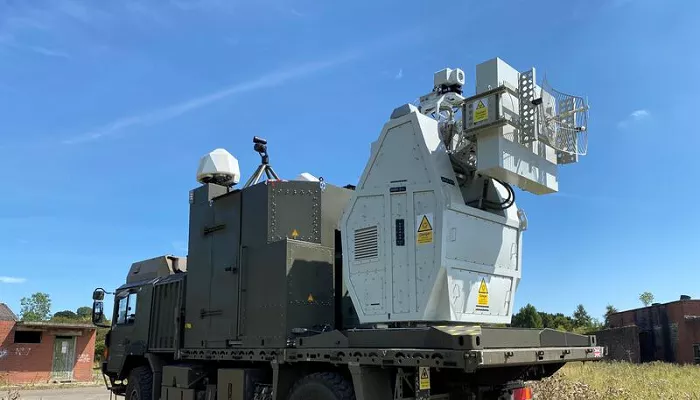The British Army has successfully tested a new Radio Frequency Directed Energy Weapon (RFDEW) that can neutralize swarms of over 100 drones simultaneously, the UK Ministry of Defence (MoD) announced. The powerful system was unveiled during the largest counter-drone exercise in British military history, held at a weapons range in west Wales.
The £40 million RFDEW system, developed under Team Hersa — a collaboration between Defence Equipment & Support, the Defence Science and Technology Laboratory, and Thales UK — uses radio waves instead of traditional munitions to disable drones by frying their electronics.
12 Cents a Shot vs. £1 Million Missiles
Unlike laser-based weapons like the UK’s DragonFire, RFDEW uses high-frequency bursts of radio energy to interfere with a drone’s critical systems. Its operational cost is astonishingly low: each burst costs just £0.10 (12 cents) — significantly cheaper than conventional surface-to-air missiles, which can cost up to £1 million per shot.
The system is effective within a 1-kilometer range and offers instant impact, making it a promising addition to both military and civilian defense infrastructure, such as airport protection and military base security.
“We found the demonstrator quick to learn and easy to use,” said Sgt Mayers, the first soldier to operate the system. “With improvements in range and power, this would be a great asset to layered air defence.”
Battlefield Use in Ukraine Likely
UK Defence sources indicated the RFDEW could soon be deployed to Ukraine, where Russia has launched over 18,000 drone attacks over the past year. With Ukraine manufacturing millions of drones — including 30,000 medium-sized strike drones in 2025 alone — the battlefield has become increasingly drone-dominated.
“As the RFDEW becomes more refined, it will certainly be taken to Ukraine,” a UK defence source said. “It could be a game changer.”
The RFDEW is particularly relevant as Ukraine and Russia both scale up their FPV and kamikaze drone capabilities, while fibre optic drones, which emit no radio signals and are immune to jamming, introduce new technological challenges. It remains uncertain whether RFDEW will be effective against these stealthier models.
A New Era of “Novel Technologies” in UK Defence
This successful trial signals a larger UK shift toward novel technologies in defense. The British government has pledged to increase defense spending to 2.5% of GDP by 2027, with 10% of that budget allocated to emerging tech.
“This significant experiment exemplifies the strength of British innovation,” said Maria Eagle, Minister for Defence Procurement. “It adds cutting-edge capabilities to the armed forces and showcases the strength of homegrown science and technology.”
Looking Ahead
Though currently mounted on vehicles, future iterations of RFDEW may become portable by individual soldiers as miniaturization advances. Its deployment on warships and around civilian infrastructure is also being explored, reinforcing the UK’s aim to lead the way in electronic warfare and drone defense.


